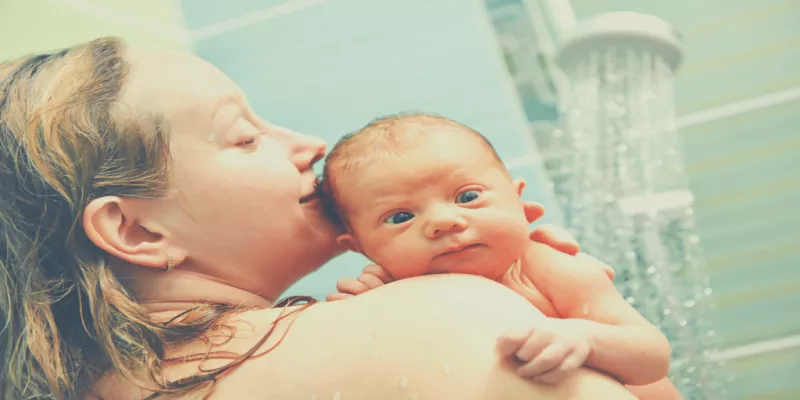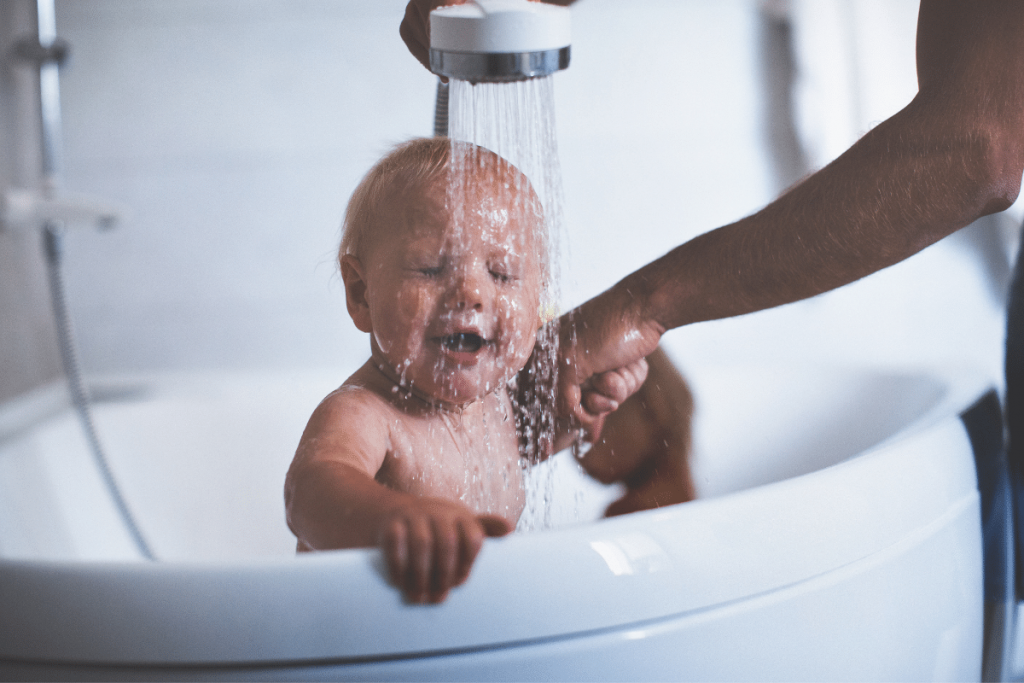Can I shower my newborn baby?

Just like adults, newborns need a bath at least 2-3 times a week. You don't need to bathe your baby every day. On other days, it's enough to wash his or her face, neck, hands, and buttocks thoroughly. You can start bathing your newborn immediately after birth, although some pediatricians recommend delaying the first bath for a few days after birth. This is because newborns are covered in vernix, also known as caseous vernix, which is a waxy substance on the skin that protects the baby from germs in the environment.
Can I shower my newborn?
If you are wondering whether you can shower your newborn instead of bathing him, the answer is yes, but make sure you follow some guidelines and have everything you need.
In fact, showering differs from bathing for the simple fact that the newborn receives the jet of water directly on the skin; therefore, it could represent a traumatic event if not done with extreme caution and delicacy.
Just like bathing, a shower 2-3 times a week is enough to keep your newborn clean; but the little one likes it, you can give it to him even once a day. Bathing or showering more than once a day can dry out your newborn's skin.
You can keep your private parts clean between baths by using warm water and cotton wool.
If you are wondering how long a newborn's bath or shower should last, here is the answer.
About 5-10 minutes is enough to thoroughly wash a newborn's body, and this is especially important if your baby has dry or sensitive skin.
And when is it best to shower your newborn? In the morning? In the evening? You can shower your newborn at any time of the day, although it would be a good idea to choose a time when you are relaxed and do not have any commitments that could interfere.
Also, it is best to avoid showering when your baby is hungry or right after a feeding. If showering relaxes your baby, you can use it as a way to encourage him to sleep at night.
You can shower your newborn in a small plastic tub or even in the bathroom sink; the latter may be easier in the first few weeks. The plastic tub is more advisable as the newborn gets older.
You can do this in any room of the house, as long as it is warm, safe and clean; however, these conditions can be found more easily in the bathroom, since it is usually the smallest room in the house and therefore can be heated more easily. In addition, it is the only room where you can access the shower arm.
How to shower a newborn baby
Before you begin, turn off or silence your cell phone to be less likely to get distracted; make sure you have everything you need on hand, such as a towel, wipe, cream or ointment, clean clothes, and a clean diaper.

When showering your baby, keep his face away from the running water and make sure to use warm, but not hot, water; avoid using soap because it will dry out your baby's skin.
If necessary, use an unscented oil or a gentle, soap-free cleanser at the end of your shower.
If you use the plastic tub, place it in a stable place and at a height where you can comfortably hold your baby; you can also place it inside the large bathtub.
Fill the plastic tub with warm water, just enough to measure the temperature, which should be between 37 and 38 degrees °C. If you don't have a thermometer (we used this one , handy in the tub and also fun for the baby to see or touch), use your wrist or elbow to test the temperature: it should be pleasantly warm.
Remove your watch and any other jewelry and wash your hands thoroughly.
Before undressing your baby, clean his eyelids (from the inner eye to the outer eye) with a cotton ball soaked in warm water and squeeze out the excess water. Use a new cotton ball for each wipe, then wash his entire face. Do not put anything in your baby's ears or nose.
Now strip him of all his clothes, removing the diaper last. Cradle his head and shoulders with one arm and support his body with the other arm, gently lower the baby into the bath, placing his feet first and then his buttocks and then his shoulders and head, always holding him tightly.
Supporting your baby's head , place him in the bathtub so that the back of his head does not hit the surface of the tub. Gently spray water on his head, without using shampoo, then gently wash his genitals and bottom, always using only water. Also check for any bits of poop, vomit or milk in the folds of his body.
If your baby shows obvious signs of discomfort when showered, you can initially also use jugs to pour water over him.
At this stage you must be especially careful not to overfill the tub, emptying it frequently; newborns, in fact, can drown in a few seconds in very shallow water. Never leave your baby alone in the bathtub, even if you are using a chair or shower seat. Never leave the newborn supervised by older children, not even for a few seconds. If for some reason you have to leave, take the newborn out of the tub.
When you have finished bathing, supporting the head and neck, lift the baby out of the tub and place him or her on his or her back on a clean, dry, soft towel; if possible, dry the baby on the floor so that he or she cannot fall. If you are using a raised surface such as a table, always keep one hand on the baby to avoid moving him or her too much and causing falls.
Wrap your baby in a towel and pat dry, paying special attention to the skin folds such as the armpits, groin, under the chin, around the neck and behind the ears.
Dress your baby, putting him in a diaper first, then move him to a safe place like a crib.
Showering a newborn baby takes practice, so try to relax and take your time. If it's your first time, you may want to get help from someone who is already familiar with newborns.
To help your baby enjoy the shower, you can try gently placing your hand on his tummy or even placing a warm, damp cloth on his chest and tummy. This can help him feel safe during the shower. Typically, babies become accustomed to bath time by about three months.
Baby Shower Chair or Booster Seat. Yes or No?

To increase the comfort of the newborn during the shower, you can also use a special chair or seat. It is usually made of hard plastic and is placed partially immersed in the water of the tub.
Designed to support the head and back, these items also help your newborn stay still, leaving your hands free to soap and wash their body.
A bath seat also allows you to bathe your baby in the large tub, without having to buy a smaller one.
There are several varieties of shower chairs and seats. For newborns, there are plastic models shaped to their body, as well as sling chairs with suspended fabric seats that allow water to pass through the fabric.
Both models are tilted back like a chair and are designed for babies who cannot sit up unaided. Older babies can be placed in a more traditional-style bath chair, which is similar to a high chair but has a bar at the front instead of a tray, a leg opening, and suction cups on the bottom to secure it to the tub.
Another option is a bath ring , which consists of a soft inflatable cushion that allows your baby to lie down and float in the water. When sitting, the ring can be secured around the baby's waist to keep him upright.



Add new comment